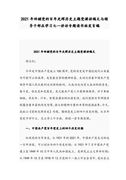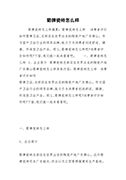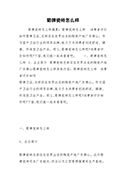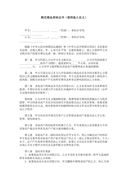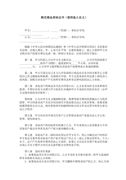北京恭王府导游词(精选8篇)
北京恭王府导游词 文档1
亲爱的朋友,欢迎您使用古游网的导游服务:
王府文化是中华民族传统文化的重要组成部分,是连接宫廷文化和平民文化的桥梁,位于北京西城区前海西街的恭王府,是中国现存王府中保存最完整的清代王府,是全国重点文物保护单位,它代表着中国的王府文化。
乾隆四十一年,即1776年,和珅开始在这东依前海,背靠后海的位置修建他的豪华宅第,时称“和第”。有说法称、明弘治年间、大太监李广也曾经置第于此。嘉庆四年正月初三,太上皇弘历归天,次日嘉庆皇帝就褫夺了和珅军机大臣和九门提督两职,抄了其全家,估计全部财富约值白银八亿两,相当于国库十几年的总收入,所以有“和珅跌倒,嘉庆吃饱”的说法,同年正月十八,即1799年2月22日,和珅被“赐令自尽”。而宅子本身,则归了“爱豪宅不爱江山”的嘉庆胞弟庆僖亲王永璘所有。与此同时,嫁给和珅儿子的乾隆之女和孝公主,仍居住在半座宅第中。咸丰元年,即1851年,清末重要政治人物恭亲王奕?成为这所宅子的第三代主人,改名恭王府,恭王府之名由此沿用至今。 “一座恭王府,半部清朝史”是历史地理学家侯仁之对恭王府的评价。民国初年,这座王府被恭亲王的孙子溥伟以40万块大洋卖给教会,后由辅仁大学用108根金条赎回,并用作女生学堂。新中国成立以后,王府曾被公安部宿舍、风机厂、音乐学院等多家单位使用过。
“月牙河绕宅如龙蟠,西山远望如虎踞”,这是史书上对恭王府的描述。就其选址而言,它占据京城绝佳的位置。古人修宅建园很注重风水,北京据说有两条龙脉,一是土龙,即故宫的龙脉;二是水龙,指后海和北海一线,而恭王府正好在后海和北海之间的连接线上,即龙脉上,因此风水非常的好。古人以水为财,在恭王府内“处处见水”,最大的湖心亭的水,是从玉泉湖引进来的,而且只内入不外流,因此更符合风水学聚财的说法。新中国十大元帅和郭沫若等人,均在恭王府的附近居住,而且都非常长寿。据说,北京长寿老人最多的地方就是恭王府附近,这个地方是一块风水宝地。
恭王府是我国保存最为完整的王府建筑群,分为府邸和花园两部分,府在前,园在后。恭王府的开放,早在30年前,就被提上议事日程。1975年,周总理在病床上,将三件未做完的事情托付给谷牧,其中之一就是恭王府的开放问题。
王府占地约3。1万平方米,分为中、东、西三路建筑,由严格的轴线贯穿着的、多进四合院落组成。王府有门脸五间,正殿七间,后殿五间,后寝殿七间,左右有配殿。府邸不仅宽大,而且建筑规模也是王府中最高的。恭王府的中、东、西三路各有三个院落,其中每一路的后两个院子是我们要游览的主要区域。
现在就请您跟随我们的讲解,游览一下这历尽苍桑、重现世人的恭王府吧。
门外院落
首先给您介绍一下王府主体院落之外的部分。在府邸大门外并列有东西两组院落。
西侧一组院落在三间正门两侧开有两座罩子门通向东、西两路院落,门的前方纵列着四排房屋,每排房屋当中各有一座阿思门,东边的阿思门外有一座影壁。
西侧院落南边沿围墙有两排倒座房,是王府的办事机构用房:前排东侧为回事处、随侍处,中间为管事处,西侧为佐领处、档子房、管领处、庄园处、置办处等,后排为粮仓房;两排倒座之间有东房一排,为裁房、厨房、水屋等。
东侧一组院落中南边沿围墙也有一排倒座房,为王府的兵房,驻有护卫王府的旗兵十余名;北边有一组四合院落,据说载滢回府时在此居住。
当时王府的总出入门就开在东侧院落的东墙上。
好了,下面我们将按照由中路入东路,转中路进西路最后到达后罩楼的顺序带领您转转这重新修缮的恭王府。
中路有正门两重,均朝南。现在您要走入的是恭王府府邸的正门,大门面阔三开间,外置石狮子一对,石狮头上的卷毛疙瘩有12排,代表亲王的爵位。
经过这中路的第一个小院,接下来您还需走过这面阔5间的二门,才能进入王府的中心区域。二门内是正殿及东西配殿,其后为后殿及东西配殿。
银安殿俗呼银銮殿,是恭王府最主要的建筑。它作为王府的正殿,只有逢重大事件、重要节日时方打开,起到礼仪的作用。民国初年,由于不慎失火,大殿连同东西配殿一并焚毁。现在经过修复,虽不能与原来的完全一样,但还是能让您体会到它的宏伟与庄重,感受到它的神韵。
现在让我们先去游览一下东路的主要建筑。下一个景点是多福轩。
多福轩采用小五架梁式的明代建筑风格。这里是奕?的会客处,保存着一些漂亮的凤凰彩绘,因其内部悬挂许多“福寿匾”而得名。多福轩内6个书架4个多宝格每个都是4米多高,全是用楠木复原的。
轩前院子内有古藤萝一架,被称为“藤莹架”,据考已生长200多年,在北京是不多见的。因此这个院子又被称为“藤萝院”。
绕过多福轩,您将进入东路的最后一个院子,看到后院的正厅乐道堂。
这里恭亲王奕忻起居的地方。奕?为皇子时,道光帝曾赐“乐道堂”匾额一方,此堂因此得名。
东路游览完了,现在请您向西走,去参观中路后院的嘉乐堂。
嘉乐堂五开间、硬山顶、前出廊,是和珅时期的建筑,悬挂“嘉乐堂”匾额一方。该匾疑是乾隆帝赐给和珅的,但匾额无署款,无钤记,故无从证实。在恭亲王时期,嘉乐堂主要作为王府的祭祀场所,内供有祖先、诸神等的牌位,以萨满教仪式为主。这就印证了民间对于王府内有座神殿的传说。
看过了银安殿和嘉乐堂,想必您已经发现了,这中轴线上建筑物的屋顶都用绿琉璃瓦、脊吻兽,而配殿屋皆用灰筒瓦。
北京恭王府导游词 篇2
各位游客:
大家好。
北京清代,有十代帝王的王子封了王位,有亲王、郡王封号的有七十个。
为了显示他们的特殊地位和便于管理,清代王府一般都设在内城。
“铁帽王府”。清初对入关有功的8家王爵,封为世袭罔替,俗称“铁帽王”,他们的王府就叫铁帽王府,共有8处,5处在西城,三处在东城。
以后又封了几个铁帽王,共12个世袭罔替王爵。
北京有两个恭亲王,一个是顺治皇帝的第五子常宁,府址在今东四十条。
恭王府位于前海西街17号,是清代规模最大的一座王府,据说恭王府总面积为一百多亩。相当于中山公园,这是至今保存最好的一座王府,曾是和珅的宅邸。
1996年10月起开放的只是恭王府的后花园,占地9亩,但其规模已经是非常可观的。
恭王府分中东西三路,分别由多过四合院组成,后为长160米的.二层后罩楼。
恭王府假山,此假山是用糯米浆砌筑成的,非常坚固,山上置两口缸,缸底有管子通到假山上,通过往缸中灌水的办法来增加院中的湿度,过去整个假山上都长满了青苔。
假山正中有一康熙皇帝为其母祝寿写的“福”字碑,这是恭王府的“三绝”之一,碑石长7.9米,贯穿整修假山。
垂花门,因门上有两个倒垂的花卉而得名,门前的两棵龙瓜槐在和珅居住时就有,这种树比较珍贵。
垂花门内的牡丹院,院中有紫藤萝架。院子正中造形呈蝙蝠形状的小湖。
在清代的北京,往住宅中引入活水,是要经皇帝特批的,恭亲王府是少有的几个享此殊荣的王府之一。
西式门,据说在当时在北京只有3个。这也是恭王府的三绝之一,另一绝是戏楼和福字碑。
花院门内的假山石,起到影壁的作用,名称为“独乐峰”。
嘉庆四年正月初三(1799年2月7日)太上皇弘历归天,次日嘉庆褫夺了和珅军机大臣、九门提督两职,抄了其家,估计全部财富约值白银八亿两,相当于国库十几年的总收入,所以有“和珅跌倒,嘉庆吃饱”的说法,2月22日和珅被“赐令自尽”。
北京恭王府导游词 篇3
恭亲王府原是“千古第一贪”的和王申的家,后被嘉庆帝立下二十四条罪状,抄了他的家充公。因最后一任主人是恭亲王爱新觉罗·奕讠斤,所以称为恭亲王府。
北京城两龙脉,一是京城中轴线,二是护城河。故宫就坐落在中轴线的头上。而恭亲王府就坐落在两龙脉相交之处。和王申曾大言不惭说:“皇上坐龙头,我坐龙尾。龙头虽掌大局,却还要龙尾行大事。”听听,和王申野心之勃勃,真不愧“千古第一贪”!
恭亲王府内,有九千九百九十九只“蝙蝠”。这“蝙蝠”并不是真实的蝙蝠,而形似蝙蝠的建筑。和王申想让自己很幸福,便取“福”的谐音字“蝠”,建了九千九百九十九只“蝙蝠”。
进门后,首先映入眼帘的,便是一只硕大的“蝙蝠”。这是一只形似蝙蝠的池塘,名曰“福池”。池岸边随意错落着假山碎石。福池周围栽满了榆树,榆树的果、叶形似铜钱,每当铜钱般的果、叶掉入福池时,和王申就会笑哈哈:“天上掉下的钱,进入我的‘聚宝盆’,地上的钱也是流入我和王申的囊袋中。”这话可真不假!
我们顺着福池潺潺流水走,便来一扇门前。这是一扇精美绝伦的西洋门,色彩鲜艳,做工精细。据说这也是他二十四条罪状之一。因为这一扇西洋门是仿造皇家园林——万寿园里的西洋门造的。
进了西洋门,绕过“送子观音”石雕,便是和王申家的戏园了。戏园前是一片花园,修剪整齐的灌木丛中开着些许花儿。《环珠格格》中“香妃戏蝶”这出戏就是在这里拍摄的。全北京城只有两处是满地青砖,一是故宫的太和殿,二便是和王申家的戏台了。因为青砖的扩音效果十分好,所以在戏台上唱戏不需要任何扩音工具,偌大的戏场人人都能听到音乐,能站在遍地青砖的戏台上为和王申等权贵大臣唱戏也是一种殊荣了。
穿过雕刻精细的朱栏长廊,便来到了和王申的书斋。书斋四面假山竹林环合,清幽宁静。整个恭亲王府,就它不是用石砖砌的。这座书斋是用一种特殊的竹料建成的,冬暖夏凉,和王申最爱待在这里了。
出书斋,前面那座十分大气的建筑就是正殿——和王申会客的地方。要上正殿,有一条很特别的路,只有一节阶梯,然后就是一条笔直平缓的坡路,因为和王申说过他这一世,只有年少时吃过苦,然后就一路平步青云,登上了“一人之下,万人之上”的权势颠峰。我们可以跨过最底下的一节阶梯,免吃一点苦,直接“平步青云”。
有这样一个故事:当年孝庄太后年老病重之时,极其爱戴她的皇孙——康熙帝,心情极其郁闷。他让侍女苏麻喇姑准备好纸笔,大笔一挥,写了一个“福”字。写完之后,玄烨和苏麻喇姑看着那个“福”字惊呆了——那个字苍劲有力,十分潇洒。细一看,竟看见了多个词组:多田,多子,多才,多寿……这不就是皇祖母的心愿吗?康熙帝越看越满意,便命人把这个“福”字拓在一块巨石上。结果,久病多时的太皇太后很快康复了!康熙帝大喜,决定将这块饱含吉祥福瑞气息的巨石代代相传,让爱新觉罗家族世代昌盛。
只可惜传到乾隆手中,就被别人偷出了皇宫。这个人就是和王申。现在这块福石就在我们正殿脚下,只露出写有“福”字的一面。这个“福”便是恭亲王府的第一万个福,寓意“万福”。和王申还神气地说:“皇上是‘万岁’,我是‘万福’!”后来,嘉庆帝抄他家时,本想把福石搬回皇宫,可还是没有搬成。和王申太狡猾了,他用石块砌了一座形似蝙蝠的福山,在“福”字左右各砌了一条龙,寓意“龙坐江山”,嘉庆帝不想自毁“江山”,便把福石留了下来。
我们刚才是“平步青云”而上,现在让我们踏着龙脉下来吧。
再沿着福山前的池塘流水走,便可来和王申家的钓鱼池,踩着朱色石船便可来到池中心的钓鱼台,钓鱼台南面堆砌着一些奇形怪状的假山,池里长满了绿色植物。北面岩上栽满了柳树,它们阿娜多姿的身体随风摇摆,与池中冒个不停的水突眼相映成趣,就像自己来到了济南趵突泉。可我回头一看,才发现自己还没离开恭亲王府呢:钓鱼台的栏杆,牌栏上无不镂刻着只有北京恭亲王府才有的蝙蝠花纹。
钓鱼池北岸上,还有一座形状奇特的阁楼,阁楼前种满了花草树木,据说是恭亲王奕讠斤派人按慈禧太后头上的旗头形状做的。奕讠斤很是讨厌慈禧太后,说:“你把我玩弄于股掌之间,我就要在你头上作威作福!”于是,奕讠斤就建了这么一个阁楼。
游完恭亲王府,我再次回首,看着这座饱经历史风霜却风采不减当年的府邸,心中百感交集:在这里住过的人,在自己事业走到颠峰时,却不知自己也走上了权途与钱途的末路。
北京恭王府导游词 篇4
各位游客:
大家好!
恭亲王府原是“千古第一贪”的和珅的家,后被嘉庆帝立下二十四条罪状,抄了他的家充公,恭王府导游词。因最后一任主人是恭亲王爱新觉罗奕讠斤,所以称为恭亲王府。
北京城两龙脉,一是京城中轴线,二是护城河。故宫就坐落在中轴线的头上。而恭亲王府就坐落在两龙脉相交之处。和珅曾大言不惭说:“皇上坐龙头,我坐龙尾。龙头虽掌大局,却还要龙尾行大事。”听听,和珅野心之勃勃,真不愧“千古第一贪”!
恭亲王府内,有九千九百九十九只“蝙蝠”。这“蝙蝠”并不是真实的蝙蝠,而形似蝙蝠的建筑。和珅想让自己很幸福,便取“福”的谐音字“蝠”,建了九千九百九十九只“蝙蝠”。
进门后,首先映入眼帘的,便是一只硕大的“蝙蝠”。这是一只形似蝙蝠的池塘,名曰“福池”。池岸边随意错落着假山碎石。福池周围栽满了榆树,榆树的果、叶形似铜钱,每当铜钱般的果、叶掉入福池时,和珅就会笑哈哈:“天上掉下的钱,进入我的‘聚宝盆’,地上的钱也是流入我和珅的囊袋中。”这话可真不假!
我们顺着福池潺潺流水走,便来一扇门前。这是一扇精美绝伦的西洋门,色彩鲜艳,做工精细。据说这也是他二十四条罪状之一。因为这一扇西洋门是仿造皇家园林——万寿园里的西洋门造的。
进了西洋门,绕过“送子观音”石雕,便是和珅家的戏园了。戏园前是一片花园,修剪整齐的灌木丛中开着些许花儿。《环珠格格》中“香妃戏蝶”这出戏就是在这里拍摄的。全北京城只有两处是满地青砖,一是故宫的太和殿,二便是和珅家的戏台了。因为青砖的扩音效果十分好,所以在戏台上唱戏不需要任何扩音工具,偌大的戏场人人都能听到音乐,能站在遍地青砖的戏台上为和珅等权贵大臣唱戏也是一种殊荣了。
穿过雕刻精细的朱栏长廊,便来到了和珅的书斋。书斋四面假山竹林环合,清幽宁静。整个恭亲王府,就它不是用石砖砌的。这座书斋是用一种特殊的竹料建成的,冬暖夏凉,和珅最爱待在这里了。
出书斋,前面那座十分大气的建筑就是正殿——和珅会客的地方。要上正殿,有一条很特别的路,只有一节阶梯,然后就是一条笔直平缓的坡路,因为和珅说过他这一世,只有年少时吃过苦,然后就一路平步青云,登上了“一人之下,万人之上”的权势颠峰。我们可以跨过最底下的一节阶梯,免吃一点苦,直接“平步青云”。
有这样一个故事:当年孝庄太后年老病重之时,极其爱戴她的皇孙——康熙帝,心情极其郁闷。他让侍女苏麻喇姑准备好纸笔,大笔一挥,写了一个“福”字。写完之后,玄烨和苏麻喇姑看着那个“福”字惊呆了——那个字苍劲有力,十分潇洒。细一看,竟看见了多个词组:多田,多子,多才,多寿……这不就是皇祖母的心愿吗?康熙帝越看越满意,便命人把这个“福”字拓在一块巨石上。结果,久病多时的太皇太后很快康复了!康熙帝大喜,决定将这块饱含吉祥福瑞气息的巨石代代相传,让爱新觉罗家族世代昌盛。
只可惜传到乾隆手中,就被别人偷出了皇宫。这个人就是和珅。现在这块福石就在我们正殿脚下,只露出写有“福”字的一面。这个“福”便是恭亲王府的第一万个福,寓意“万福”。和珅还神气地说:“皇上是‘万岁’,我是‘万福’!”后来,嘉庆帝抄他家时,本想把福石搬回皇宫,可还是没有搬成。和珅太狡猾了,他用石块砌了一座形似蝙蝠的福山,在“福”字左右各砌了一条龙,寓意“龙坐江山”,嘉庆帝不想自毁“江山”,便把福石留了下来。
北京恭王府导游词 篇5
尊敬的各位旅客,亲爱的小朋友们:
大家早上好!我是导游梁景雯,很荣幸能做大家的向导,今天我们要去的地方是,北京市的恭王府,请大家耐心等待!
朋友们,我们来到著名的北京恭王府了,你们知道为什么叫恭王府吗?它曾是和珅的府邸,1851年恭亲王奕昕成了宅子的主人。这座恭王府是清代规模最大的一座王府,它经历了大清王朝七代皇帝的统治,它就如一面镜子,见证大清王朝由鼎盛而变的衰亡的历史进程,承载了极为丰富的历史文化信息,便有了“一座恭王府,半部清代史”的说法。
现在,大家看看府中的窗户,原来和珅是一个大贪官,在他宅子的南面,是一排青砖瓦房,一共有99间半,他就把他的金银财宝全藏在里面,可是,好多人担心他找不见啥放在哪儿,呵!不用担心!我不是让大家看府中的窗户嘛,这些窗户形状不一,有三角形,有不规则的形状,还有礼裙形。我们不得不佩服古人的智慧。我给大家五分钟休息时间,休息完我们继续出发!
老北京人常说:“来北京,一定要到故宫沾沾王气,到长城沾沾霸气,到恭王府沾沾福气!”这个“福”字是康熙的御笔,现在在秘云洞里保存着。这个福字呢,写得比较讲究,右上角像个“多”,下面像个“田”,左面像个“才”“子”,右边上下连起来像个“寿”,合起来叫:多子、多才、多田、多寿、多福,被称为“五福”。
据说,恭王府里有9999只“福”,第一万个在秘云洞,他被称为“天下第一福”。好了,我带大家去摸一下福,把福带回家,切记:只快速摸一下福,这样能快速把福摸到手。
大家一定摸到了福吧!请大家慢慢游览,祝大家旅途愉快!再见!
北京恭王府导游词 篇6
各位游客大家好。
恭亲王府原是“千古第一贪”的何坤的家,后被嘉庆帝立下二十四条罪状,抄了他的家充公。因最后一任主人是恭亲王爱新觉罗·奕訢,所以称为恭亲王府。
北京城两龙脉,一是京城中轴线,二是护城河。故宫就坐落在中轴线的头上。而恭亲王府就坐落在两龙脉相交之处。何坤曾大言不惭说:“皇上坐龙头,我坐龙尾。龙头虽掌大局,却还要龙尾行大事。”听听,何坤野心之勃勃,真不愧“千古第一贪”!
恭亲王府内,有九千九百九十九只“蝙蝠”。这“蝙蝠”并不是真实的.蝙蝠,而形似蝙蝠的建筑。何坤想让自己很幸福,便取“福”的谐音字“蝠”,建了九千九百九十九只“蝙蝠”。
进门后,首先映入眼帘的,便是一只硕大的“蝙蝠”。这是一只形似蝙蝠的池塘,名曰“福池”。池岸边随意错落着假山碎石。福池周围栽满了榆树,榆树的果、叶形似铜钱,每当铜钱般的果、叶掉入福池时,何坤就会笑哈哈:“天上掉下的钱,进入我的?聚宝盆?,地上的钱也是流入我何坤的囊袋中。”这话可真不假!
我们顺着福池潺潺流水走,便来一扇门前。这是一扇精美绝伦的西洋门,色彩鲜艳,做工精细。据说这也是他二十四条罪状之一。因为这一扇西洋门是仿造皇家园林——万寿园里的西洋门造的。
进了西洋门,绕过“送子观音”石雕,便是何坤家的戏园了。戏园前是一片花园,修剪整齐的灌木丛中开着些许花儿。《环珠格格》中“香妃戏蝶”这出戏就是在这里拍摄的。全北京城只有两处是满地青砖,一是故宫的太和殿,二便是何坤家的戏台了。因为青砖的扩音效果十分好,所以在戏台上唱戏不需要任何扩音工具,偌大的戏场人人都能听到音乐,能站在遍地青砖的戏台上为何坤等权贵大臣唱戏也是一种殊荣了。
穿过雕刻精细的朱栏长廊,便来到了何坤的书斋。书斋四面假山竹林环合,清幽宁静。整个恭亲王府,就它不是用石砖砌的。这座书斋是用一种特殊的竹料建成的,冬暖夏凉,何坤最爱待在这里了。
出书斋,前面那座十分大气的建筑就是正殿——何坤会客的地方。要上正殿,有一条很特别的路,只有一节阶梯,然后就是一条笔直平缓的坡路,因为何坤说过他这一世,只有年少时吃过苦,然后就一路平步青云,登上了“一人之下,万人之上”的权势颠峰。我们可以跨过最底下的一节阶梯,免吃一点苦,直接“平步青云”。
北京恭王府导游词 篇7
Prince Gong's house used to be the home of Wang Shen, the most greedy one in all ages. Later, Emperor Jiaqing made twenty-four charges and confiscated his house. Because the last host was Prince Gong's Aixinjueluo, it was called Prince Gong's mansion.
There are two dragon veins in Beijing, one is the central axis of Beijing, the other is the moat. The Palace Museum is located at the head of the central axis. Prince Gongqin's residence is located at the intersection of the two dragon veins. He and Wang Shen once boasted: "the emperor sits on the dragon's head, I sit on the dragon's tail. Although the dragon's head is in charge of the overall situation, it still needs the dragon's tail to do great things. &"Listen, he and Wang Shen are so ambitious that they deserve to be the first greedy people of all ages.";!
There are 9999 bats in Prince Gongqin's mansion;. This is not a real bat, but a bat like building. Wang Shen and Wang Shen wanted to be happy, so they took the homonym of "Fu" and built 9999 bats;.
When you enter the door, the first thing you see is a huge bat;. This is a bat like pond called "Fu Chi";. Rockery and gravel are randomly scattered on the Bank of the pool. Elm trees are planted around Fuchi. The fruit and leaf of elm trees are like copper coins. When the fruit and leaf like copper coins fall into Fuchi, Wang Shen and I will laugh and laugh: & < money falling from the sky enters my & ‘ cornucopia & >, and the money on the ground also flows into Wang Shen and I. &"That's true!
We followed the gurgling water of Fuchi and came to a door. This is a beautiful western gate with bright colors and fine workmanship. It is said that this is one of his 24 counts. Because this western gate was made after the western gate in the royal garden.
After entering the western gate and bypassing the stone carving of "Songzi Guanyin", it is the opera garden with Wang Shen's family. In front of the play garden is a garden, with some flowers in the trim bushes. The play "Xiangfei plays butterfly" in huanzhuge was shot here. Only two places in Beijing are covered with green bricks. One is the Taihe hall in the Forbidden City, and the other is the stage with Wang Shen's family. Because the sound amplification effect of the green brick is very good, singing on the stage does not need any sound amplification tools. In such a large theater, everyone can hear music, and it is also a great honor to stand on the stage full of green bricks and sing for the powerful ministers such as Wang Shen.
Through the well carved Zhulan corridor, you come to the study with Wang Shen. The study is surrounded by rockery and bamboo groves, quiet and quiet. The whole Gongqin palace is not built with stone bricks. This study is made of a special kind of bamboo. It is warm in winter and cool in summer. Wang Shen and I like to stay here most.
Out of the study, the magnificent building in front is the main hall & — & — and the place where Wang Shen meets visitors. To get to the main hall, there is a very special road. There is only one ladder, and then there is a straight and gentle slope road, because I told Wang Shen that in his life, he had suffered only when he was young, and then he went all the way to the peak of power. We can cross the bottom of the ladder, avoid suffering, and go straight to the top;.
There is a story: when the Empress Dowager of Xiaozhuang was very old and sick, she loved her grandson Emperor Kangxi very much and was very depressed. He asked Su malagu, his maid, to prepare her pen and paper, and with a stroke of her pen, she wrote "Fu". After finishing the writing, Xuanye and Su malagu look at the word "Fu" and are stunned & — & — the word is powerful and natural. If you look closely, you can see many phrases: more fields, more sons, more talents, more longevity & … & … isn't this the wish of the emperor's grandmother? The more Emperor Kangxi saw it, the more satisfied he was, he ordered people to put the word "Fu" on a huge stone. As a result, the empress dowager, who had been ill for a long time, soon recovered. Emperor Kangxi was so happy that he decided to pass on this auspicious and auspicious stone from generation to generation, so that the Aixinjueluo family could prosper from generation to generation.
Unfortunately, when it reached Qianlong, it was stolen out of the palace. This person is Wang Shen. Now this stone is at the foot of our main hall, only showing the side with the word "Fu". This & " blessing & " is the 10th blessing of Prince Gongqin's mansion, which means & " ten thousand blessings & ". And Wang Shen also said with an air: & < the emperor is & ‘ long live & >, I am & ‘ Wanfu & >! & > later, when Emperor Jiaqing copied his house, he wanted to move the Fushi back to the palace, but he still didn't. He and Wang Shen are too cunning. He built a bat like Fushan with stones, and built a dragon on the left and right of the word "Fu", implying that "the Dragon sits on the River Mountain". Emperor Jiaqing didn't want to destroy himself, so he left the stone.
Just now, we are going up the road. Now let's step on the dragon's pulse.
After walking along the pond in front of Fushan, you can come to the fishing pool with Wang Shen's family. You can walk on a red stone boat to the Diaoyutai in the center of the pool. To the south of the Diaoyutai, there are some grotesque rockeries, and the pool is full of green plants. Willow trees are planted on the rocks to the north. Their bodies sway with the wind, which makes them look like they came to Baotu Spring in Jinan. But when I look back, I find that I haven't left Prince Gongqin's residence yet: the railings of Diaoyutai are engraved with bat patterns that only prince Gongqin's residence in Beijing has.
On the North Bank of the fishing pond, there is also an attic with a peculiar shape. In front of the attic, plants and trees are planted. It is said that Prince Gong Yi Chen Jin sent people to make it according to the shape of the flag head on Empress Dowager Cixi's head. Yi Chen Jin hated Empress Dowager Cixi very much and said, "if you play with me, I'm going to bully you!".
After visiting Prince Gongqin's mansion, I look back again and look at this historic mansion. I have mixed feelings in my heart: when people who lived here reached the peak of their career, they didn't know that they were on the end of the road of power and money.
北京恭王府导游词 篇8
Prince Gong's residence is located in the northwest of Beijing, near Qianhai in the East and Houhai in the north. In the early stage, a canal from the northeast corner of Jishuitan (West Sea) water area in Deshengmen bypassed the west wall of Prince Gong's residence, turned outside the south wall (commonly known as Yueya River), and flowed into Shichahai (Qianhai) through three bridges. Facing water in the West and south, and near water in the East and North, it can be said that it is surrounded by water and has a beautiful environment. By the early 1950s, the canal had been filled up to form Liuyin street and qianhaixi street.
Prince Gong's residence was first built in 1776, with a history of more than 230 years. In the fourth year of Jiaqing, he was convicted and his house was confiscated. After that, the house was pided into two parts: the East and the West. Emperor Jiaqing of the West gave the house to his younger brother Prince Yonggui, and the East left it to the ten princesses. In the first year of Chengfeng (1851), Emperor Xianfeng gave the whole palace to Prince Gong Yi? To live in. So far, it was named Prince Gong's palace, which is still in use today. Please remember the two main masters of the garden: big corrupt official and Prince Gong Yi?.
Prince Gong's residence is 330 meters long from north to South and 180 meters wide from east to west. There are dozens of palaces in Beijing, which were either destroyed or used for other purposes. Only Prince Gong's mansion, which has been preserved in its original style, is open to the outside world. As an ancient garden of Manchu royal family, it is composed of two parts: Mansion and garden, covering an area of more than 60000 square meters, including 32000 square meters of mansion and 28000 square meters of garden.
The buildings in the mansion are pided into three roads: the East Road, the middle road and the west road. From the south to the north, they are composed of many three-way quadrangles with strict central axis. The layout is clear. The east road goes to park Shanghua, the middle road is solemn and solemn, and the west road is simple and elegant. The three roads are self-contained and harmonious. In these houses, there are not only the buildings reflecting the royal style and majesty, but also the exquisite architecture and decoration style from the folk, which constitute the biggest feature of the royal culture. The garden integrates Jiangnan garden and Northern architecture, and integrates western architecture and Chinese classical garden architecture. Prince Gong's mansion is not only one of the important representatives of the Qing Dynasty's mansion architecture, but also an important performance of the most mature period of Chinese traditional architecture and gardening skills. Mr. Hou Renzhi, a famous scholar, called it "a palace of Prince Gong, half of the history of Qing Dynasty".
Prince Gong's house was listed as a key national protection unit in 1982, and the garden of Prince Gong's house was opened to the public in 1988. In the process of my explanation, in order to better protect this precious heritage and ensure the safety of your visit to the park, please cooperate. First, do not smoke. Second, do not climb rocks. Third, take good care of your belongings. Fourth, take good care of the environment and do not litter in the park
1、 The first master of the mansion, he (born in 1750 A.D. in the 15th year of Qianlong and died in 1799 A.D. in the 4th year of Jiaqing), was originally named Shanbao, with the word zhizhai and the surname niuhulu. He belonged to the Zhenghong banner of Manchuria (once carried into zhenghuang banner, but his family members were classified as Zhenghong banner after being convicted). )Among the eight banners, they are not aristocrats (eight banners are pided into yellow flag, yellow flag, white flag, white flag, red flag, red flag, blue flag and blue flag). The yellow flag, the yellow flag and the white flag led by the emperor were the upper three banners, the nobles and the lower five banners. )How could he be the greatest favorite of Emperor Qianlong if he was not born into a noble family and had no degree of Jinshi
There are five main reasons why he is favored
First, smart. He? Has an amazing memory, makes a clear reading and makes a smart decision. Even Jiaqing affirmed that he was "smart and agile". When he was a child, he studied in Xianan palace, the best school in the capital at that time (Xianan palace is in the Imperial Palace, which is equivalent to the current national key school. It mainly recruits the children of the internal affairs government and eight banners officials who are both good-looking and good-looking). He is proficient in Manchu, Chinese, Mongolian and Tibetan Languages, and can be both civil and military. At the age of 19, he inherited the position of third-class light truck captain earned by his ancestors. Three years later, there was another vacancy for the third class bodyguard, which gave him a chance to get close to Emperor Qianlong.
Second, the United tobacco royal family. His son, Fengshen Yinde, was given the name by Emperor Qianlong, which means longevity in Manchu. Moreover, Qianlong married his 65 year old daughter Gu Lun and Princess Xiao to his son Fengshen Yinde. The relationship between Emperor Qianlong and "he" changed from the relationship between master and slave, the relationship between monarch and minister to the relationship between daughter and family, and Qianlong became the real umbrella of "he".
Thirdly, according to unofficial history, I remember that when Hongli was young (later Emperor Qianlong), I once played in the palace and saw nianguifei combing her hair. Nianguifei was the younger sister of general Nian genyao of the Qing Dynasty and one of the top ten beauties of the Qing Dynasty. Her name was nianqiuyue. Hongli was moved by her beauty and secretly went over to cover her eyes from behind. Qing, Nian's concubine was startled and didn't know who was behind. She picked up the hairpin and rowed back, which just cut Hongli's forehead. Later, the empress learned about it, because it spread that it was not good for Hongli's reputation (she was the Royal concubine of Yongzheng, Hongli should call her erniang. )Next year, the imperial concubine hanged herself. Hongli cried bitterly at that time, because one of his frivolous actions killed Nian Guifei. I secretly vowed that when I became an emperor, I would meet again, not to repair this life and the afterlife. So stained with cinnabar, she printed a red fingerprint behind her ear. Many years later, when Hongli became emperor, he was Emperor Qianlong. When he first saw him, he was still a stick guard. Qianlong was surprised and felt that he looked like the young lady who died many years ago. So he stepped down from the throne and asked if there were any sisters in his family. He said that there were only two brothers, he and he?. When the emperor was disappointed, he suddenly saw a red mole behind his ear. It was not only similar to nianguifei's face, but also the size and location of the mole. So the emperor thinks that he? Is the reincarnation of Nian Guifei. So the emperor kept him close to him and favored him. He also used his intelligence to please Qianlong. As a result, his position and status rose like a helicopter. Within three years, Emperor Qianlong passed orders to promote him to the position of official. He almost made all kinds of high-ranking officials in the Qing Dynasty. He had been a military aircraft Minister for 23 years, and was known as the second emperor.
Many friends come to Prince Gong's residence with admiration. The film and television works also make a lot of hype about ho. However, there is a big gap between the real image of Ho and the image of the film and television works. Ho is a real beautiful man with a white face, quick action, dignified and humorous speech.
The second master, Prince Gong Yi? (1833-1898), was the sixth son of Emperor Daoguang. He was named Prince Gong in the imperial edict of Emperor Daoguang in 1850. He was an important and influential figure in the political situation of the late Qing Dynasty. After the death of emperor Xianfeng in 1861, he and Cixi jointly launched the "Xinyou coup" to eliminate eight ministers, such as SUSHUN, which paved the way for Cixi to reach the peak of power. After that, he was appointed as the king of political affairs, walked on the military plane, and participated in military affairs as a prince, which was very rare in the Qing Dynasty. As a "leader", he, together with Zeng Guofan, Zhang Zhidong and other feudal officials, set off the famous "Westernization Movement" in modern Chinese history. Under his invitation and planning, the Qing government established in 1860 the first official "Ministry of foreign affairs" in Chinese history, the premier's national affairs yamen, to deal with foreign affairs. In 1862, under his own planning, the Qing government established the capital Tongwen school in Beijing. The establishment of Tongwen school was the beginning of the establishment of a new school in China. It entered the school of Beijing Normal University in 1902 and became the earliest part of the establishment of Peking University. It seems that the prince of the late Qing Dynasty has a certain relationship with Peking University. Yi? Was the sixth son of Emperor Daoguang. At that time, he was famous for his foreign affairs. Therefore, people nicknamed him GUI Zi Liu, and he didn't mind. Because Yi? Was very independent and active in politics, he was afraid of Empress Dowager Cixi. Later, he lost power and lived in seclusion in Jiehe temple. Yi? Became the tenth iron hat king of the Qing Dynasty in 1872. He is the author of the collection of works of ledaotang. After the Sino Japanese War of 1894-1895, it was used again. It was the Prime Minister of the Navy, the Council for military affairs, and the inner court. He died in 1898 with the posthumous title of "Zhong". )
2、 Scenic spots in the mansion
The main hall of the palace of yin'an, commonly known as "yin'an hall", is the place where important ceremonial activities are held. A group of screens and the throne of the prince are placed in the center of the hall. It corresponds to the Jinluan Hall of the Forbidden City. Jinluan hall was the place where the emperor summoned and held important ceremonies.
The tall building you see now was newly built in this overhaul as it was in the Guangxu reign of Tongzhi. The original yin'an hall, together with the East and west side halls, was destroyed by burning incense on the night of the Lantern Festival on January 15, 1921.
The new construction process of yin'an Hall:
The yin'an hall was built according to the strict Architectural Regulations of the Qing Dynasty and the highest standard roof of the royal palace.
Tourists, please observe the color of the tiles on the roof of the main hall, the number of animals on the roof ridge, the number of doornails on the main door, etc. How are they different from the palace museum you can see?
The roof of the imperial palace is covered with golden colored glass, which is the symbol of imperial power; the roof of the main hall of the Royal Palace is covered with green colored glass tiles, and the roof of the auxiliary hall is covered with gray tiles, which indicates the prince's status.
In ancient architecture, door nails were only used on board doors. Originally used to guard against the enemy's fire attack, so Zhuoyi was covered with mud to prevent fire. Doornails are usually made of copper. In the Qing Dynasty, the use of door nails was regulated. In royal architecture, there are nine nails for each door, nine in each direction, and a total of ninety-nine and eighty-one nails. Nine is the pole of Yang number, symbolizing the highest status of the emperor. Because the imperial temple is dedicated to the emperors of the past dynasties, it also has nine road studs; seven roads in the Royal Palace take seven roads, but seven roads in the prince's palace take nine roads; further down there are five roads take five roads.
Duofuxuan is commonly known as "tengluoyuan". The main hall was called "Yanxi hall" in the period of peace, which was the residence of the son and Princess of peace. It was called "duofuxuan" in the period of Prince Gong. It was the hall and living room of the palace. It was mainly used by the host to receive visitors, relatives and friends or subordinates who came to report back to the official affairs. It was also used to store gifts sent by the emperor. "Duofuxuan" was inscribed by Emperor Xianfeng. It means the palace of a lot of happiness. The plaque of "Tongde Yanxi" is hung in the center of the hall, which is intended to warn the host that only when you and the emperor have the same virtue can you extend the Xi (XI: good luck and long life). Please observe carefully that the four walls of the hall near the ceiling are all hung with the inscription of "Fu Shou". The inscription of "Fu Shou" is written on the red square paper (i.e. "Dou Fang") and is placed in a shuttle shape. The inscription of "Fu Shou" is made in pairs.
Since the reign of Kangxi in the Qing Dynasty, every winter, the emperor had to write the words "Fu" and "Shou" in person and give them to the king, the Duke, the minister and the empress. The word "Shou" will be added to every major birthday celebration. According to convention, the old "Fu Shou" Dou Fang can not be removed. Instead, the new "Fu Shou" Dou Fang is pasted directly on the old one, meaning "Fu Tian Shou". Now what you see is the original copy.
Please carefully observe the Phoenix and seal painting of Qianlong period on the roof beam. Although only partial Phoenix Tail pattern remains, it has special value. Its existence confirms that Fudi East Road was once Princess mansion.
Hexi painting is also known as palace architectural painting. This kind of architectural painting is the highest level painting in the Qing Dynasty, mostly painted on palace buildings or buildings related to the royal family
Ledaotang is the largest building on the East Road and the last one to enter the courtyard. The main room is called "ledaotang". On the interior beams, there are two hundred years of colorful paintings of baojindi and Phoenix in the middle Qing Dynasty, which indicates that it was the residence of the princess during the period of peace. In the period of Prince Gong, this is the living room of the prince. Now the interior is displayed as it was when Prince Gong lived. The plaque of "ledaotang" was given to Yi? By Emperor Daoguang himself. It expresses a father's wish for his son's happiness and auspiciousness.
He is not a prince. In the Qing Dynasty, when the feudal hierarchy was very strict, why did he build such a luxurious private house in spite of large-scale construction? You can see the reason from the following records.
Yin De, the son of he, was born on the 19th of the first month of the 40th year of Qianlong (1775), half a month younger than Princess He Xiao. He and Qianlong formed a family of sons and daughters, and became the most unattainable relatives of the emperor. He Jianhe house was actually built as Princess House, so he Jianhe house was built according to the double specifications of Princess House and first-class officials of the imperial court
Jiale Hall
Jiale hall is the hall name of Hejin period. It is said that the plaque of Jiale hall was given to Hejin by Qianlong. During the period of Prince Gong, it was the "Temple", that is, the place where Shamanism activities were held.
Shamanism sacrificial activities: Ancient Mongolians believed in Shamanism first. Shamanism worships gods and pides the world into three kinds: heaven above, earth in the middle and hell below.
The most important way of Shaman sacrifice is to worship ancestors and heaven. It is said that the ancestors of Manchu people fell into a trap in a battle and had to hide in a big tree in a hurry. The birds on the tree did not move, so they did not expose the ancestors of Manchu people to the enemy and let them survive. Therefore, Manchu people revered the birds as gods.
Grand Theater
The grand theater building of Prince Gong's mansion, built during the reign of tongzhi (1862-1874), is a place for Prince Gong and his relatives to watch the opera. This theater is the only existing fully enclosed theater in China. In the archives of the Qing Dynasty, theatrical buildings were called "big theatrical rooms". The building area is 685 square meters, and its architectural form adopts a three volume hook and build fully enclosed structure. It is said that although the whole theater building is of brick and wood structure, it does not use an iron nail. In particular, it is worth mentioning the sound effect of the Grand Theater. In order to ensure the fidelity of the sound, several large tanks are placed under the stage. The ingenious and special structure increases the resonance reverberation space, so that the audience can clearly hear the singing of the actors without any sound transmission tools at any position in the theater. Once, after a famous singer came here to sing, he excitedly praised that the timbre effect of the grand theater building was better than that of the concert hall.
In the peony courtyard, the location of the theater is general, but the inside is resplendent. On both sides of the stage, the two pillars, the four walls and the top are all painted with twigs and vines. The scene of green leaves and purple flowers in full bloom makes people feel like watching the Opera under the vines. It is said that at that time, even Empress Dowager Cixi was sitting in the courtyard. Prince Gong worried that he would be guilty of overstepping the system, so he painted a lot of vines on the roof, which means that this is the vines rack, not the lobby. It's very kind of him. There are 20 large palace lanterns hanging on the top of the shed, and 20 eight immortals tables with Taishi chairs are placed in an orderly manner. The back walls of the theater are light brown wooden lattice, with dark blue silk cloth as the bottom lining. On the south side of the hall is a stage about one meter high. Above the stage, there is a black plaque with gold characters, which is written with four seal characters of "enjoy yourself". In the south, there is an actor's dressing room in the backstage and a stage in the front. In the north, there are places for VIPs and their wives to watch and rest. Yi's birthday is in the late October of the lunar calendar. When holding a birthday party, a fire is needed, so the Grand Theater is also called "warm building" by the government. In addition to acting, it was also the place where the wedding ceremony was held in Prince Gong's mansion. Every time the important figures in the mansion die, the theater will be full of couplets, buildings, cigarettes, long hanging, and monks and nuns in each temple will sprinkle sutras one after another to pass the dead.
In 1936, Pu Ru, the grandson of Prince Gong Yi? Who lived in the garden at that time, celebrated his mother Mrs. Xiang's birthday and organized a hall play in the theater. At that time, famous actors in the Peking Opera circle gathered in the Grand Theater and performed on the stage one after another. This is the last meeting of Prince Gong's mansion. Now?

